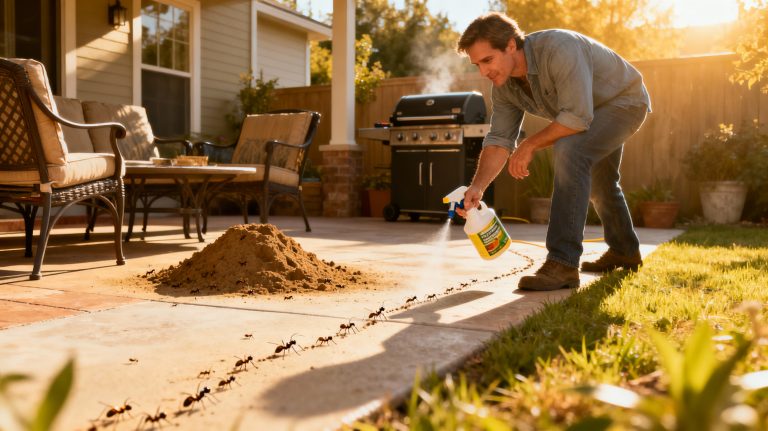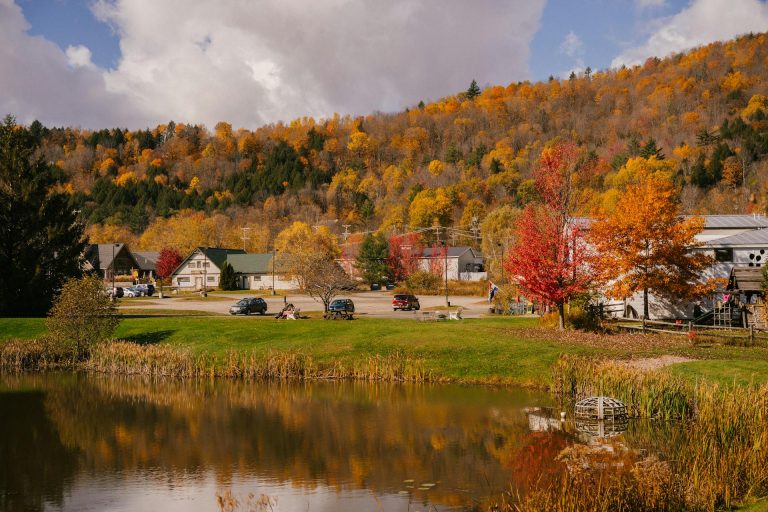The good news: you don’t have to fog your yard with harsh chemicals to take the ants out of the patio. If you’re searching “best ways to kill ants outside without harsh chemicals,” you’re in the right place.
First move: follow the busiest ant line all the way to its source and mark that mound; that’s the one you’ll treat today. You might be looking at a crumbly little dirt volcano that rebuilds overnight, or a glossy line of workers along the grill pad that never seems to end.
Repelling Ants vs Killing a Colony: The Key Difference
Repelling ants and killing a colony are not the same job. Wiping trails with vinegar or sprinkling cinnamon can scatter them, but the queen continues to lay eggs, and the workers re-route.
A simple cue: if your fix makes them “disappear” for a day and then they pop up two feet away, you repelled them. To end it, you need to hit the mound or feed the queen via bait.
Start Here: Two Low‑Toxicity Ways to End a Colony
Scalding Water Mound Drench, No Chemicals
-
Heat 2-3 gallons of water to near boiling (careful this burns). Early morning is best.
-
Slowly pour directly into the mound opening and across the surface so it penetrates chambers. Expect some turf singe right at the mound.
-
What you’ll see and when: the mound will collapse and activity will drop immediately. Check again in 24-48 hours. If you still see fresh soil pellets, repeat once.
Food‑Grade Diatomaceous Earth on Dry Days
-
On a dry morning, dust a light ring of DE around the mound and along the active trail. Think “powdered sugar,” not snowdrifts.
-
Keep it dry. Reapply after rain or heavy dew.
-
What you’ll see and when: within a day you’ll notice fewer ants crossing the dusted line. Over several days, traffic thins dramatically around the mound if conditions stay dry.
Why These Methods Work, and Sprays Alone Don’t
Ant colonies run on division of labor and pheromone maps. Kill a handful of workers on the surface and the colony shrugs. Replace the map and they redraw it. Kill or starve the queen and the colony folds.
Drenches reach brood and deeper workers. Baits let workers carry a slow acting toxin home and share it, which is why they beat “contact kills” for long term control. Some harsh sprays are repellent. They can even cause colonies to split (bud) and spread. That’s the trap you’re avoiding.
Low‑Impact Baits That Actually Finish the Job
If you’d rather not pour hot water or you’re dealing with multiple small colonies use outdoor baits with gentler actives. Look for:
-
Boric acid/borate baits in sealed outdoor stations. Workers take tiny doses back to the queen. You get a slow, thorough collapse.
-
Spinosad granule baits (a soil derived, OMRI listed option). Labeled for yard use and excellent on fire ants. You can sprinkle a light band along trails or use dedicated stations per the label.
Place baits right along the foraging line, a foot or so from the mound, and keep them dry. Don’t dump them on top of the mound (ants won’t feed during alarm). Give them fresh bait weekly until traffic stops.
You’ll usually see lines thin in 3-5 days, with a big drop by week two. We see the same pattern in most yards: folks try strong-smelling “natural” sprays, the ants move, and nothing changes until a bait goes into the mix.
Natural Mound Drenches & No Boiling Needed
Citrus oil (d‑limonene) and mild soap make an effective contact drench that works as a homemade fire ant killer. Mix about 1-2 ounces of orange oil plus a tablespoon of liquid dish soap per gallon of water. Slowly pour 1-2 gallons into the mound so it soaks in.
D‑limonene dissolves the ants’ waxy coating. Soap helps it spread. You’ll get quick knockdown like hot water, with less risk of scalding yourself. Test away from delicate plants concentrated citrus oils can burn foliage and turf.
What to Skip Outdoors & What to Use Only as Backups
Cinnamon, coffee grounds, cayenne, lemon juice, and vinegar are useful for breaking trails or guarding a doorway, but they rarely touch the queen. Essential oils like peppermint or tea tree can be decent short term barriers on a patio edge. They don’t eliminate a colony outdoors.
Diatomaceous earth is great until it gets wet. Reapply after rain. And no, cornmeal doesn’t make ants explode. If you want fewer ants tomorrow, use bait or a drench today.
Safety for Kids, Pets, & Pollinators
Natural doesn’t mean risk free, so a few practical guardrails help. Use only food grade DE and avoid breathing the dust during application. Keep all baits in labeled, tamper resistant stations and place them where little hands and paws can’t reach.
Spinosad is hard on bees when wet. Use it in bait form and keep it away from flowering areas. Citrus oils and many essential oils can irritate pets store concentrates carefully and skip spraying near pet beds. Hot water works, but do it when kids and pets are inside and you’ve got solid footing.
How to Know You’re Winning: What to Expect by Week Two
-
In a day or two: fewer workers on trails you treated. Mound looks quiet instead of “boiling.”
-
By the end of the week: no fresh soil pellets around the mound after morning. Trails are spotty or gone.
-
After two weeks: zero new mound building in that zone. If a fresh mound appears nearby, treat it the same way sometimes satellites surface once the main colony collapses.
If You’re Dealing with Fire Ants: Bait Then Drench
In warm, humid regions, fire ants are both painful and persistent though fire ant predators can help. A gentle but effective approach is “bait then drench”: apply spinosad bait around mounds on a dry day, wait a few days for feeding, then use a hot water or citrus oil drench on any still active mounds. Wear gloves and closed shoes. Don’t excavate a fire ant mound unless you want a fast lesson in stings.
You’ve got options that work without dousing the yard. Start with the mound you marked, choose either a drench or a low impact bait (or both), and give it a week. If you stick to one clear plan instead of scattering repellent tricks, you’ll see real, lasting results.
If you’d rather not play ant chess, our team uses low tox methods like spinosad baits in secure stations and targeted citrus or hot water drenches. We identify species, find satellite colonies, and set a schedule that’s safe around kids and pets. Whether you DIY or call us, you’ll end up with a clear plan and a usable yard again we can usually diagnose the same week.













